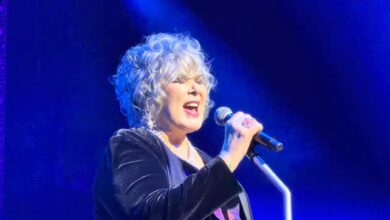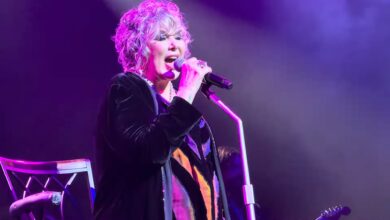Metallica Unleash Chaos and Unity with a Thunderous “For Whom The Bell Tolls” in Adelaide 2025
By the time November 5 rolled around, Adelaide Oval felt less like a cricket ground and more like a pilgrimage site. Metallica hadn’t played Australia in over a decade, and the M72 World Tour finally rolling into South Australia turned the whole CBD into a rolling sea of black shirts, worn denim, and sunburned smiles. Fans who’d grown up on cassette copies of Ride the Lightning queued alongside teenagers in 72 Seasons merch, all buzzing with the same nervous excitement: the world’s biggest metal band was about to turn this postcard-perfect stadium into a two-hour earthquake.
The build-up had actually started days earlier. Metallica’s pop-up shop at Queen’s Theatre became a kind of unofficial embassy, where out-of-towners grabbed exclusive Adelaide prints, splatter vinyl and tour shirts before wandering off to compare setlist predictions over pints. Contest winners flashed Snake Pit wristbands like golden tickets, while locals bragged about scoring seats close to the catwalk or right under the pyro rigs. Everything about the Adelaide date screamed “event”: tickets sold out, enhanced experiences snapped up, and social feeds jammed with photos of the Oval being transformed into a 360-degree metal amphitheatre under the early summer sky.
Inside the venue, the story started well before Metallica walked on. Suicidal Tendencies charged out first, turning early arrivals in the lower stands into a roiling pit of circle-dancing diehards. Even those stranded in traffic and only catching the tail end felt the energy spike as Mike Muir stalked the stage, cap pulled low, barking old-school hardcore refrains. Evanescence followed and shifted the tone entirely; Amy Lee’s voice rolled around the stadium like a cathedral bell, transforming songs like Going Under and Bring Me to Life into mass sing-alongs that bridged goth rock, nu-metal nostalgia and arena pop drama in one sweep.
Then came the moment every Australian Metallica fan secretly dreams of: AC/DC through a monster PA. As Long Way to the Top blasted from the speakers, archival Metallica footage flashed across the giant cylindrical screens, reminding everyone exactly how many eras this band has survived. When the last bagpipe shriek faded, Ennio Morricone’s The Ecstasy of Gold rolled in, and the crowd roared like someone had pressed a detonator. People who’d seen the band multiple times still pulled out their phones to capture the ritual; for first-timers, this was the instant where a stadium show crossed over into something mythic.
Metallica hit the stage at 8:10pm sharp, and Creeping Death was their first real swing. Bathed in blood-red light, the band sounded feral and weirdly youthful, as if the long break from Australia had shaved years off the set. James Hetfield paced the stage like a seasoned general, that familiar bark cutting through the night while Lars Ulrich’s drums ricocheted around the Oval’s curves. Kirk Hammett’s leads sliced across the PA, Robert Trujillo’s bass rattled the seats, and out on the lawn whole sections of the crowd were already headbanging in unison, fists in the air for that iconic “Die! Die!” chant.
Without even catching their breath, they slammed straight into For Whom The Bell Tolls, and the entire evening seemed to lock into focus. The low, ominous chime of the intro boomed across the stadium, while Trujillo’s distorted bass line rumbled like something dragging chains across the Oval turf. In the 4K fan video now circulating online, you can see the stands ripple as that first riff lands—thousands of people suddenly moving like one organism, heads nodding in perfect time as the cameras zoom between the band and the seething front rows.
What made this version of For Whom The Bell Tolls feel special wasn’t just the sound; it was the way the band and crowd treated it like a shared war story. Hetfield prowled the front of the stage, barking out verses with that gravelly half-snarl, half-grin he’s perfected over four decades, while Hammett leaned into those climbing lead lines with the kind of swagger that says, “We know exactly how huge this is.” On the floor, fans punched the air to every chorus, others drummed the tom pattern on railings, and even in the upper decks you could see pockets of people screaming the lyrics like they were back in high school.
The cameras capturing the 4K clip did their own bit of storytelling. From one angle you see the sea of phone screens glow white as the bells toll, from another you catch the Snake Pit losing its collective mind as the riff slams back in after each breakdown. There’s sweat steaming off bodies under the stage lights, security guards mouthing the words, and one brief pan that sums the night up perfectly: a kid in a brand new 72 Seasons tee on their parent’s shoulders, both yelling “For whom the bell tolls!” like their lives depend on it. It’s the kind of footage that will live online for years as the definitive snapshot of Adelaide’s M72 chaos.
From there, the set moved through eras like flicking through a record collection in real time. Leper Messiah brought a dose of deep-cut satisfaction for the Master of Puppets faithful; King Nothing reminded everyone that the Load era still slaps when it’s this loud and this tight. Fade to Black cloaked the stadium in blue light and lighters—well, phone torches—creating a moment of almost uncomfortable vulnerability as Hetfield’s voice cracked just slightly on the high notes, then gave way to Hammett’s soaring solo that had people genuinely wiping their eyes between fist pumps.
Fuel did exactly what its title promises. Each time the chorus hit, pillars of flame erupted from the stage corners, throwing heat all the way to the back stands and lighting up the Oval like a refinery had exploded in the middle of Adelaide. Moth Into Flame took that sensory overload even further, with neon visuals turning the stage into a vertigo-inducing collage of swirling colours and glitching patterns. It was a reminder that Metallica’s modern production is closer to a sci-fi film than a simple rock show, and still they never let the screens distract from the sheer physicality of four people playing very, very loud music.
Then came the most uniquely Australian moment of the night: the Kirk and Rob “doodle.” Left alone on stage, Hammett and Trujillo slipped into the seductive groove of INXS’s Need You Tonight before pivoting into the opening lines of The Angels’ Am I Ever Gonna See Your Face Again. That was all it took. The rest belonged to Adelaide. The infamous response—“No way, get fucked, fuck off!”—roared back from every corner of the stadium, turning a global metal tour into a full-blown local rite of passage. Even for seasoned Metallica followers, it was one of those “you had to be there” spikes of pure crowd electricity.
The emotional centre of the set was built around The Day That Never Comes, Nothing Else Matters and One. The former unfolded slowly, its clean, almost fragile intro echoing around the venue before exploding into jagged riffs and machine-gun drumming. Nothing Else Matters gave Hetfield another chance to show how his voice has aged into something rough but strangely tender, with huge swathes of the crowd swaying arm in arm. One, as always, was the moment the stadium turned into a battlefield: tracer-like lights, exploding pyro and grim war footage across the screens made the familiar song feel freshly unsettling again.
By the home stretch, the show had shifted from “great gig” to “instant folklore.” Seek & Destroy resurrected the band’s scrappy thrash roots, but played with the muscle and confidence of a unit that now casually fills stadiums. Lux Æterna worked far better live than some sceptics expected, a jolt of new-era speed metal that had even the older heads nodding along. Master of Puppets, meanwhile, felt like a shared language across generations—every breakdown a cue for air-downpicking, every “Master!” chant a multi-storey call-and-response that rattled the stadium seats.
Enter Sandman was, fittingly, the final exclamation mark. As the first riff rang out, fireworks ripped into the Adelaide night sky, framing the stage in bursts of red and gold while confetti cannons sent metallic streamers over the front sections. You could see it on the band’s faces: that mix of exhaustion and elation that only comes after dragging an entire city through two hours of noise and catharsis. When the last chords faded and the house lights finally came up, people just stood there for a minute, stunned, before slowly drifting toward the exits still humming riffs under their breath.
What really made Adelaide feel special, though, was the sense that it wasn’t just another stop on a very long tour. This was their first time back in the country since Soundwave 2013, and you could feel a decade’s worth of pent-up demand in every sold-out seat, every Facebook comment calling the show “epic beyond words,” every hoarse voice on the tram ride home. Diehards praised the setlist balance—old-school bangers like Creeping Death and For Whom The Bell Tolls sitting comfortably next to newer cuts like Lux Æterna and Moth Into Flame—while casual fans still walked away having heard every “must play” classic they’d hoped for.
Zoom back out and the Adelaide gig takes on even more weight. Just days earlier in Perth, Metallica had tipped their hat to Aussie culture with a surprise tease of John Butler Trio’s Zebra; now, in Adelaide, they doubled down by leaning into INXS and The Angels, letting the crowd turn a pub-chant into stadium thunder. This wasn’t a band phoning in a greatest-hits package—it was Metallica actively weaving themselves into the local rock mythology of every city they hit, and Adelaide might have gotten the most perfectly tailored moment of all.
And so that 4K clip of For Whom The Bell Tolls, shot from somewhere in the stands on a warm November night, ends up feeling like more than just another fan video. It’s a tiny time capsule of a city welcoming back a band that helped soundtrack its youth, of parents and kids screaming along to a song written long before the younger ones were born, of Metallica proving yet again that their riffs are built to survive changing fashions, formats and generations. Years from now, when people talk about the M72 Australian run, Adelaide’s bells will still be ringing.





